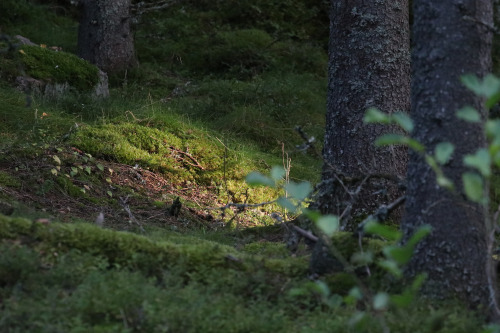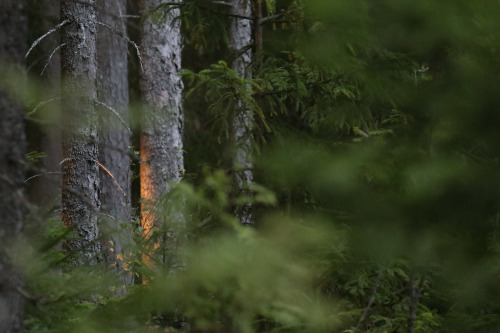A Quiet Moment.




A quiet moment.
More Posts from Eggxecutive-dysfunction and Others

Milky Way over the Pinnacles in Australia : What strange world is this? Earth. In the foreground of the featured image are the Pinnacles, unusual rock spires in Nambung National Park in Western Australia. Made of ancient sea shells (limestone), how these human-sized picturesque spires formed remains unknown. In the background, just past the end of the central Pinnacle, is a bright crescent Moon. The eerie glow around the Moon is mostly zodiacal light, sunlight reflected by dust grains orbiting between the planets in the Solar System. Arching across the top is the central band of our Milky Way Galaxy. Many famous stars and nebulas are also visible in the background night sky. The featured 29-panel panorama was taken and composed in 2015 September after detailed planning that involved the Moon, the rock spires, and their corresponding shadows. Even so, the strong zodiacal light was a pleasant surprise. via NASA
New Sun Science Stamps from the U.S. Postal Service
To start off the summer, the U.S. Postal Service issued a set of stamps showcasing views of the Sun from our Solar Dynamics Observatory!

Since its launch in 2010, the Solar Dynamics Observatory (or SDO) has kept up a near-constant watch on the Sun from its vantage point in orbit around Earth. SDO watches the Sun in more than 10 different types of light, including some that are absorbed by Earth’s atmosphere so can only be seen from space. These different types of light allow scientists to study different parts of the Sun – from its surface to its atmosphere – and better understand the solar activity that can affect our technology on Earth and in space.

The new set of stamps features 10 images from SDO. Most of these images are in extreme ultraviolet light, which is invisible to human eyes.
Let’s explore the science behind some of the stamps!
Coronal hole (May 2016)

The dark area capping the northern polar region of the Sun is a coronal hole, a magnetically open area on the Sun from which high-speed solar wind escapes into space. Such high-speed solar wind streams can spark magnificent auroral displays on Earth when they collide with our planet’s magnetic field.
Solar flare (August 2011)

The bright flash on the Sun’s upper right is a powerful solar flare. Solar flares are bursts of light and energy that can disturb the part of Earth’s atmosphere where GPS and radio signals travel.
Active Sun (October 2014)

This view highlights the many active regions dotting the Sun’s surface. Active regions are areas of intense and complex magnetic fields on the Sun – linked to sunspots – that are prone to erupting with solar flares or explosions of material called coronal mass ejections.
Plasma blast (August 2012)

These images show a burst of material from the Sun, called a coronal mass ejection. These eruptions of magnetized solar material can create space weather effects on Earth when they collide with our planet’s magnetosphere, or magnetic environment – including aurora, satellite disruptions, and, when extreme, even power outages.
Coronal loops (July 2012)

These images show evolving coronal loops across the limb and disk of the Sun. Just days after these images were taken, the Sun unleashed a powerful solar flare.
Coronal loops are often found over sunspots and active regions, which are areas of intense and complex magnetic fields on the Sun.
Sunspots (October 2014)

This view in visible light – the type of light we can see – shows a cluster of sunspots near the center of the Sun. Sunspots appear dark because they are relatively cool compared to surrounding material, a consequence of the way their extremely dense magnetic field prevents heated material from rising to the solar surface.
For more Sun science, follow NASA Sun on Twitter, on Facebook, or on the web.
Make sure to follow us on Tumblr for your regular dose of space!
AND YET A TRACE OF THE TRUE SELF EXISTS IN THE FALSE SELF


whats cookin' good chookin

I almost forgot 😅 American Crow scribbled real fast, feather shapes are wrong and proportions are wack but it’s already tomorrow and I’m behind as is haha.
Inktober 09

Moustached Grass-Warbler (Melocichla mentalis)
© Antoon De Vylder
We just caught our second ever real life image of a black hole and this one is in our own galactic neighborhood and the internet isn't memeing it into oblivion or even talking about it. Tragic, truly. Sad, even.


They're in love y'know. Not that you care

-
 bluemoonandtheocean liked this · 2 months ago
bluemoonandtheocean liked this · 2 months ago -
 trukqsxxxii reblogged this · 1 year ago
trukqsxxxii reblogged this · 1 year ago -
 all-you-had-to-do-was-neigh reblogged this · 1 year ago
all-you-had-to-do-was-neigh reblogged this · 1 year ago -
 doitlikeadog liked this · 1 year ago
doitlikeadog liked this · 1 year ago -
 trukqsxxv reblogged this · 1 year ago
trukqsxxv reblogged this · 1 year ago -
 radiopacifica reblogged this · 1 year ago
radiopacifica reblogged this · 1 year ago -
 gremlynslemyns reblogged this · 1 year ago
gremlynslemyns reblogged this · 1 year ago -
 atanpultio liked this · 1 year ago
atanpultio liked this · 1 year ago -
 inthenameoffeelings liked this · 1 year ago
inthenameoffeelings liked this · 1 year ago -
 werewolfest liked this · 1 year ago
werewolfest liked this · 1 year ago -
 voronoid-android reblogged this · 1 year ago
voronoid-android reblogged this · 1 year ago -
 mathanpoppy27 liked this · 1 year ago
mathanpoppy27 liked this · 1 year ago -
 0-i0 liked this · 1 year ago
0-i0 liked this · 1 year ago -
 rainbowpui liked this · 1 year ago
rainbowpui liked this · 1 year ago -
 megan-renee reblogged this · 1 year ago
megan-renee reblogged this · 1 year ago -
 trekkitkat liked this · 1 year ago
trekkitkat liked this · 1 year ago -
 aaustinwrites reblogged this · 2 years ago
aaustinwrites reblogged this · 2 years ago -
 vlvtcherry reblogged this · 2 years ago
vlvtcherry reblogged this · 2 years ago -
 trukqsxxiv reblogged this · 2 years ago
trukqsxxiv reblogged this · 2 years ago -
 360nw liked this · 2 years ago
360nw liked this · 2 years ago -
 llovelyclouds liked this · 2 years ago
llovelyclouds liked this · 2 years ago -
 ciphers-crypt reblogged this · 2 years ago
ciphers-crypt reblogged this · 2 years ago -
 rogeshadow liked this · 2 years ago
rogeshadow liked this · 2 years ago -
 electric-charms liked this · 2 years ago
electric-charms liked this · 2 years ago -
 bloodyfairytears liked this · 2 years ago
bloodyfairytears liked this · 2 years ago -
 l-aniakea liked this · 2 years ago
l-aniakea liked this · 2 years ago -
 themorningstarqueen liked this · 2 years ago
themorningstarqueen liked this · 2 years ago -
 etheplant reblogged this · 2 years ago
etheplant reblogged this · 2 years ago -
 from-the-woods reblogged this · 2 years ago
from-the-woods reblogged this · 2 years ago -
 laisio liked this · 2 years ago
laisio liked this · 2 years ago -
 lieblichesnichts reblogged this · 2 years ago
lieblichesnichts reblogged this · 2 years ago -
 missbliss12 liked this · 2 years ago
missbliss12 liked this · 2 years ago -
 clytemnestra7777 reblogged this · 2 years ago
clytemnestra7777 reblogged this · 2 years ago -
 ulan-bator liked this · 2 years ago
ulan-bator liked this · 2 years ago -
 elenmeadows liked this · 2 years ago
elenmeadows liked this · 2 years ago -
 megan-renee reblogged this · 2 years ago
megan-renee reblogged this · 2 years ago -
 loona4eva12 liked this · 2 years ago
loona4eva12 liked this · 2 years ago -
 babyfireflyisdead liked this · 2 years ago
babyfireflyisdead liked this · 2 years ago -
 megan-renee reblogged this · 2 years ago
megan-renee reblogged this · 2 years ago -
 ascendant-mood liked this · 2 years ago
ascendant-mood liked this · 2 years ago -
 meticulousmaker liked this · 2 years ago
meticulousmaker liked this · 2 years ago -
 vreenak reblogged this · 2 years ago
vreenak reblogged this · 2 years ago -
 seniorinternaut liked this · 2 years ago
seniorinternaut liked this · 2 years ago


